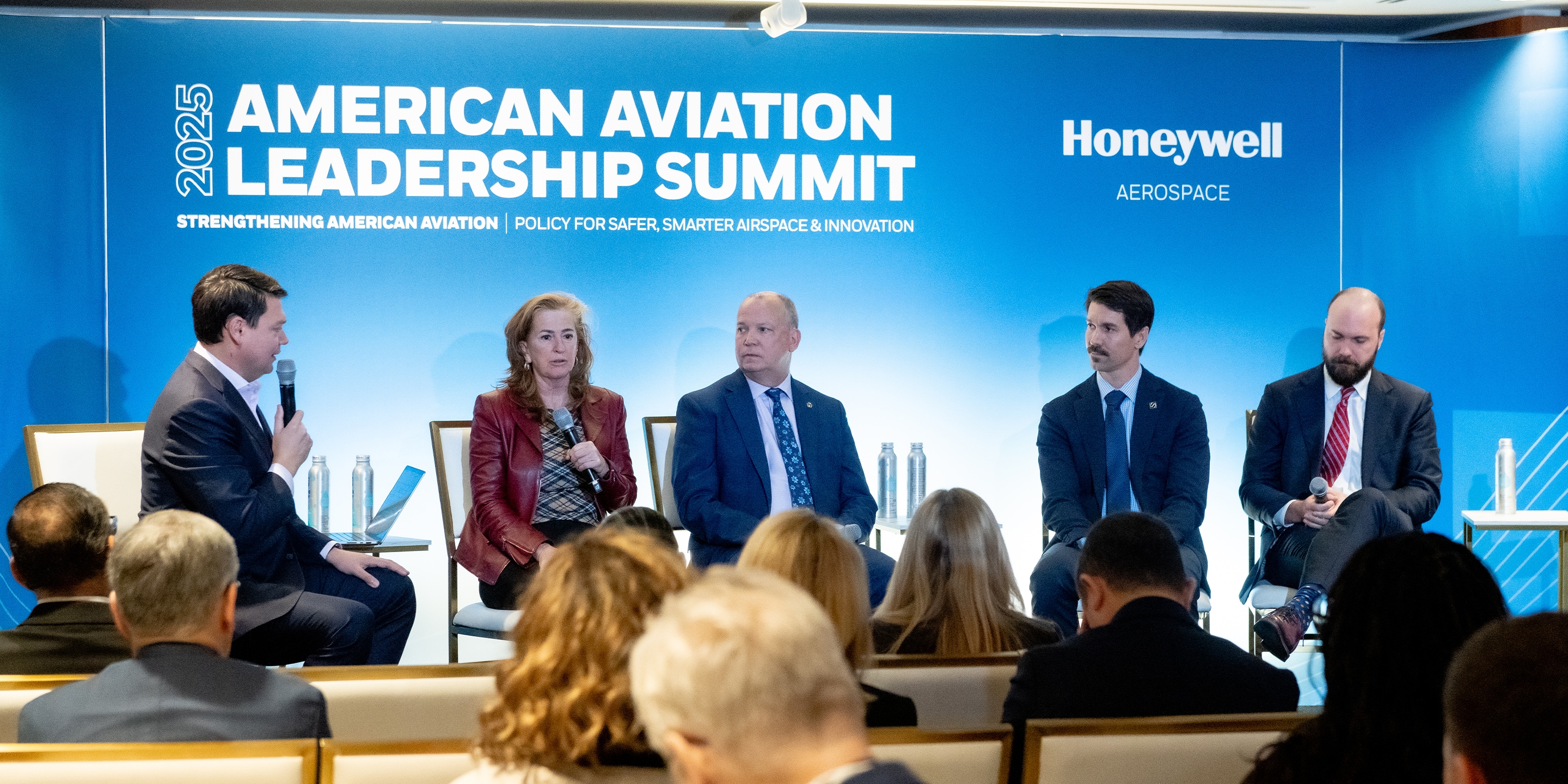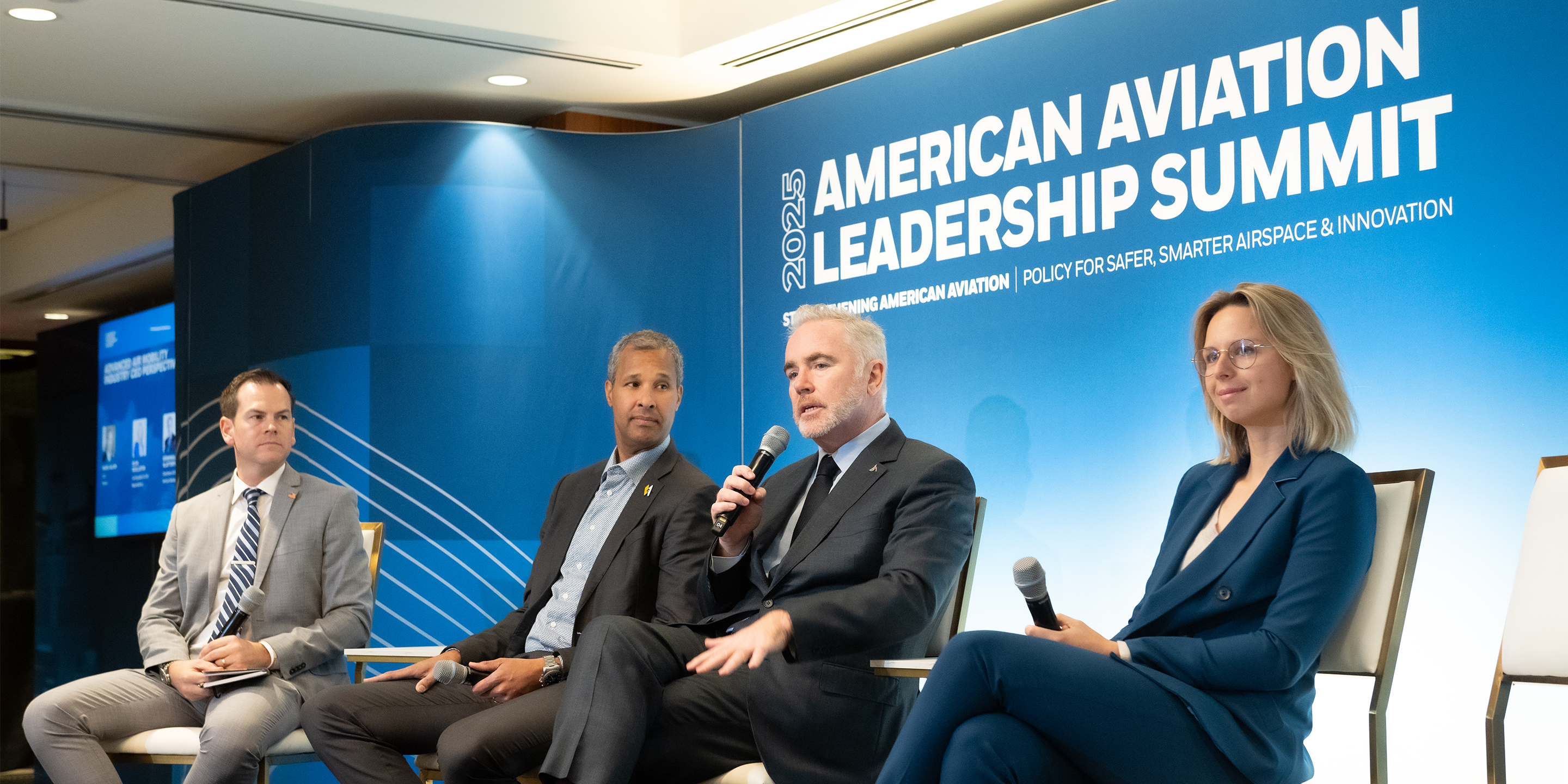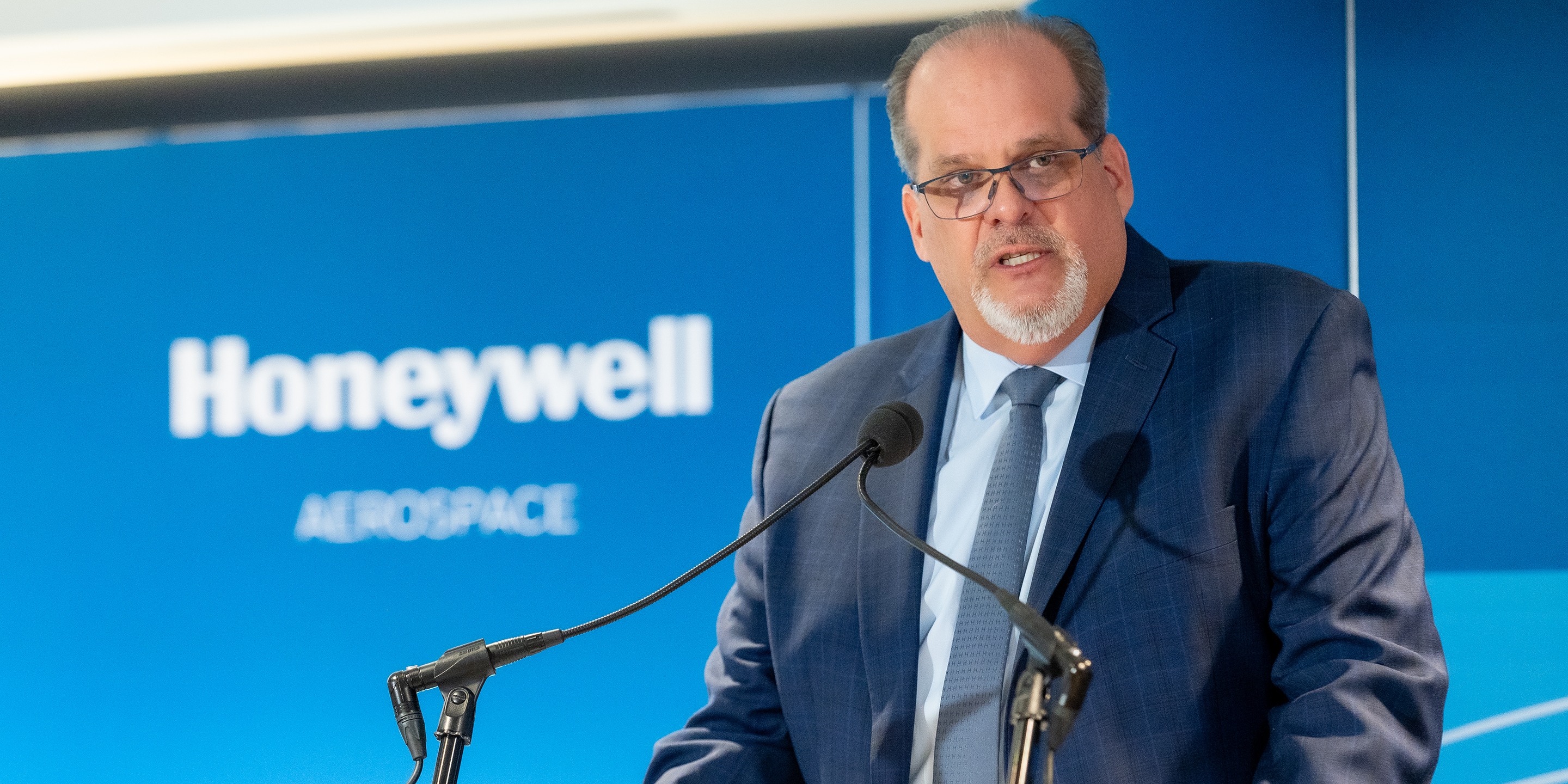Your browser is not supported.
For the best experience, please access this site using the latest version of the following browsers:
By closing this window you acknowledge that your experience on this website may be degraded.
7 Insights from the 2025 American Aviation Leadership Summit
7 Insights from the 2025 American Aviation Leadership Summit
Discover key industry insights from the American Aviation Leadership Summit hosted by Honeywell Aerospace, highlighting safety, smarter airspace and innovation.
“We are defined by performance, by engineering that solves challenges, by mission outcomes that matter, and by an unshakeable commitment to those who fly, defend and connect the world, because in the skies we share, leadership and accountability and responsibility must go hand in hand.”
-Jim Currier, President & CEO, Honeywell Aerospace
The aviation landscape is rapidly evolving, shaped by dynamic technologies, increasing demands and an urgent need for sustainable progress. At the 2025 American Aviation Leadership Summit hosted by Honeywell Aerospace, industry professionals, policymakers and technology leaders gathered to foster discussions around collaboration and unified progress. This pivotal event underscored how collective efforts – across government, manufacturers, operators, and industry groups – pave the way for safer, smarter skies.

The Power of Partnership: Industry, Government and the Public United
“There's a structure we're forced to work in the government, [but] I think we can move more quickly. When I was in Congress, what you realize is your time is limited … I want to maximize our time. I want to make the biggest impact and difference possible. And that means, again, move right, but move fast.”
-Sean Duffy, US Secretary of Transportation
Aviation has always thrived on partnership, and in today’s rapidly evolving landscape, collaboration is more essential than ever. This spirit of collaboration was on full display at the Summit, where numerous government officials – Members of Congress, US Secretary of Transportation Sean Duffy, FAA Administrator Bryan Bedford, and Florida Secretary of Transportation Jared Perdue – participated in various panels alongside top aviation contributors. Across all discussions, there was a consistent focus on partnership, both among companies and in cooperation with the government, reinforcing that progress is not driven by a single company but rather by a network of contributors and regulators committed to advancing aviation’s technology, safety and reliability.

Modernizing Airspace: Infrastructure, Integration and Innovation
As demand for air travel grows and new types of aircraft – such as electric vertical take-off and landing (eVTOL) vehicles – begin to enter service, it is vital to ensure seamless and safe integration. Driving this continued innovation and growth in aviation safety technology, without compromising safety in the skies, can only be achieved through shared investment, open standards, and regulatory engagement.
Beyond new and additional aircraft being added to the national airspace, it is also important to recognize that aviation infrastructure itself is more than technology – it is the people behind these innovations and processes who matter just as much. It will be critical to invest in more training and staffing as traffic grows and systems become more complex.
“Deploying simulation technology for training air traffic controllers ... is going to make an immediate difference in getting more air traffic controllers into the system more quickly.”
-Sharon Pinkerton, Senior Vice President, Legislative & Regulatory Policy, Airlines 4 America (A4A)
Driving Safety Innovation: Shared Advancements and Policy Engagement
Aviation’s legacy of safety innovation is the result of decades of joint efforts – combining technical ingenuity with strong policy support. During the panel on Enhancing Aviation Safety, it was highlighted that the industry has been continuously innovating to drive greater increase in safety and efficiency through advancements in enhanced ground proximity warning systems (EGPWS), traffic collision avoidance systems (TCAS), Surface Alerts (SURF-A) for runway safety and more.
These tools are a few examples of how industry-wide cooperation has saved lives. The remarks shared by panelists reflect a broad consensus: progress in aviation safety is everyone’s responsibility, requiring shared investment in innovation, open standards and regulatory engagement. The Summit also highlighted calls for policymakers to consider new requirements that could accelerate the adoption of life-saving technologies across fleets.
Transforming Air Traffic Control: Modernization and Safety Integration
“We believe there needs to be more room in the conversation in parallel with ATC modernization for aircraft-level technology improvements.”
-Bob Buddecke, President, Electronic Solutions, Honeywell Aerospace
When it comes to safety and its overlap with ATC modernization, a key topic that influenced several panels was the recent government shutdown and its large-scale impact on the aviation and airline industry. While the shutdown created many non-aviation related issues, the ones it created for those flying during its 41 days could not be ignored, as more than six million people experienced record-breaking Transportation Security Administration (TSA) lines, delays and cancelations to maintain safety margins.
Numerous options to help mitigate these issues were discussed throughout the day, including the recently introduced Aviation Funding Stability Act – which would protect the FAA’s operational continuity should another shutdown occur. Advancements in technology would also enable air traffic controllers with the information necessary to stop incidents from happening well in advance and the countless technologies already in place for the industry to build upon, such as ADS-B and TCAS. Additionally, the growing enhancements involving artificial intelligence, which Secretary Duffy stated was already being employed to identify various “hotspots” in the national airspace and take action early.
Harnessing Data and AI: Predictive Safety and Responsible Innovation
As advanced air mobility (AAM) continues to be an emerging technology, so does the exponentially growing use of artificial intelligence. There is no doubt technologies like predictive maintenance and real-time monitoring are transforming aviation safety and reliability, helping operators anticipate and prevent problems before they occur while keeping humans in the loop.

Representative Jay Obernolte, who not only has a background in computer science but is also co-chair of the bipartisan AI Task Force for Congress, spent a majority of his fireside chat reminding attendees that although AI is a powerful tool with incredible potential, it still has its faults.
“It all hinges on our approach and the approach we ought to take, particularly in aviation and risk management. We never, ever assume that AI is doing exactly what we think it is going to do. We never assume that the output of AI is a hundred percent correct. We always verify.”
-Representative Jay Obernolte (R-CA)
The responsible use of data and AI will only be achieved through ongoing dialogue between technology leaders, regulators and end users. With the right regulations in place and the opportunity to evolve safely, this collaboration will pave the way for innovative solutions and transformative advancements that will shape a brighter, more resilient future for aviation and beyond.

Advanced Air Mobility: A Not-So-Distant Future
“I strongly believe, one day, aviation will be electric. And I think … we are all part of that wave for sure.”
-Eloa Guillotin, Cofounder & CEO, Beyond Aero
Advanced air mobility is moving from concept to reality at an astonishing pace. The aircraft are real, they are already flying and original equipment manufacturers (OEMs) are making steady progress toward FAA and global certification and, ultimately, entry into service. Under America's Innovate28 roadmap, the FAA is accelerating efforts to achieve AAM operations at scale by 2028.
At the Summit, AAM leaders showcased a range of cutting-edge aircraft – from hydrogen electric to hybrid electric, and VTOL to ultra-short takeoff and landing – highlighting the diverse capabilities, dramatic reduction in travel times, society-wide benefits and more efficient potential of new entrants to the market.
But the US is at risk of falling behind as global competitors accelerate their innovation and progress. Summit participants urged immediate action to make AAM a national priority, establish clear regulations and public engagement to lead AAM innovation.
“If we flash out 50 years from now, these mega cities are only getting bigger. There's no more room for bigger highways, and so everything will go up into the sky. And to do that, we have to do it in the safest possible way at the lowest possible price.”
-Dómhnal Slattery, Chairman of the Board, Vertical Aerospace
Advancements in AAM are accelerating innovation across aviation, from high-energy-density batteries and hybrid-electric propulsion systems to advanced autonomy, lightweight composite structures and next-generation compact fly-by-wire control systems and health-monitoring systems.
Looking Ahead: Uniting for Future Challenges and Opportunities
“At a time when there appears to be no top end for demand for air travel, it allows us to get more out of the infrastructure we have. It also greases the skids for these disruptive new entrants … the VTOLs, the STOLs, the autonomous players,” David Shilliday, Vice President & General Manager, AAM, Honeywell Aerospace, stated at the closing of the Summit. The aviation industry faces a horizon filled with both challenges and promise: integrating advanced air mobility vehicles, improving efficiencies across aircraft and ensuring safe operations in ever-busier skies. But success will depend on continued collaboration between all stakeholders – manufacturers, operators and government.

The Skies We Share: A Call to Action
“In this moment, one truth is clear: American aerospace must continue to lead – lead in innovation, lead in capability, lead in safety and resilience, lead in shaping the future of flight.”
-Jim Currier, President & CEO, Honeywell Aerospace
The American Aviation Leadership Summit brought together leaders from government, industry, defense and technology at a pivotal time for this vital and dynamic sector. The future of flight will be shaped by the combined efforts of visionary professionals, engaged policymakers and innovative technologists. By working together, the aviation community can continue to advance safety, modernization and innovation. The call to action is clear: only through partnership can we realize the full potential of aviation, ensuring a bright and boundless future and preserving American leadership for generations to come.
Let's Connect!
The latest news in aerospace backed by expert insights
Sign up to receive the latest news about events, special offers and related topics via email and other forms of electronic communication.

